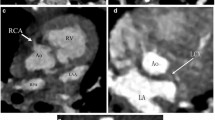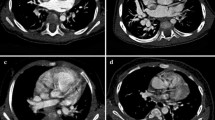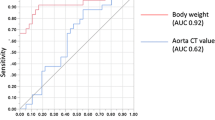Abstract
Background: There is little information on the ability of non-ECG-gated cardiac CT to demonstrate the coronary arteries of children. Objective: To evaluate the visibility of the origin and proximal course of coronary arteries on non-ECG-gated cardiac CT, in which the coronary artery was not of primary diagnostic concern, in children with congenital heart disease. Materials and methods: From December 2002 to March 2004, 126 cardiac CT examinations from 104 children (median age 11 months; age range 1 day to 15 years) were evaluated. All patients had ventriculo-arterial concordance and no malformations of the great arteries; those with coronary artery anomalies were excluded. Contrast-enhanced 16-slice spiral CT was performed without ECG-gating and multiplanar images for coronary arteries were obtained. The visibility of coronary artery origins was graded on a three-point scale, while nine segments of the arteries were graded on a four-point scale. CT images in which it was possible to trace the coronary arteries were considered diagnostic. The visibility of each whole coronary artery and the origins and proximal four segments of coronary arteries were calculated. The visibility of coronary arteries was also correlated with patient age. Results: The percentage of CT images of diagnostic quality was 49.3% for the whole coronary artery and 81.7% for the origins and proximal four segments. There was a significant positive correlation between the visibility of coronary arteries and age. Conclusions: Non-ECG-gated cardiac CT, in which the coronary artery is not of primary diagnostic concern, is frequently able to visualize the origin and proximal course of coronary arteries and may be helpful in detecting coronary artery anomalies in children with congenital heart disease.





Similar content being viewed by others
References
Schoenhagen P, Halliburton SS, Stillman AE, et al (2004) Noninvasive imaging of coronary arteries: current and future role of multi-detector row CT. Radiology 232:7–17
Schoepf UJ, Becker CR, Ohnesorge BM, et al (2004) CT of coronary artery disease. Radiology 232:18–37
Pannu HK, Flohr TG, Corl FM, et al (2003) Current concepts in multi-detector row CT evaluation of the coronary arteries: principles, techniques, and anatomy. Radiographics 23:S111–S125
Danias PG, Stuber M, Botnar RM, et al (2003) Coronary MR angiography clinical applications and potential for imaging coronary artery disease. Magn Reson Imaging Clin N Am 11:81–99
Ropers D, Baum U, Pohle K, et al (2003) Detection of coronary artery stenoses with thin-slice multi-detector row spiral computed tomography and multiplanar reconstruction. Circulation 107:664–666
Nieman K, Cademartiri F, Lemos PA, et al (2002) Reliable noninvasive coronary angiography with fast submillimeter multislice spiral computed tomography. Circulation 106:2051–2054
Bogaert J, Kuzo R, Dymarkowski S, et al (2003) Coronary artery imaging with real-time navigator three-dimensional turbo-field-echo MR coronary angiography: initial experience. Radiology 226:707–716
Ropers D, Moshage W, Daniel WG, et al (2001) Visualization of coronary artery anomalies and their anatomic course by contrast-enhanced electron beam tomography and three-dimensional reconstruction. Am J Cardiol 87:193–197
White CS, Laskey WK, Stafford JL, et al (1999) Coronary MRA: use in assessing anomalies of coronary artery origin. J Comput Assist Tomogr 23:203–207
Taylor AM, Thorne SA, Rubens MB, et al (2000) Coronary artery imaging in grown up congenital heart disease: complementary role of magnetic resonance and x-ray coronary angiography. Circulation 101:1670–1678
Angelini P, Velasco JA, Flamm S (2002) Coronary anomalies: incidence, pathophysiology, and clinical relevance. Circulation 105:2449–2454
Goo HW, Park IS, Ko JK, et al (2003) CT of congenital heart disease: normal anatomy and typical pathologic conditions. Radiographics 23:S147–S165
Goo HW, Park IS, Ko JK, et al (2005) Computed tomography for the diagnosis of congenital heart disease in pediatric and adult patients. Int J Cardiovasc Imaging (in press)
Wang Y, Vidan E, Bergman GW (1999) Cardiac motion of coronary arteries: variability in the rest period and implication for coronary MR angiography. Radiology 213:751–758
Giorgi B, Dymarkowski S, Maes F, et al (2002) Improved visualization of coronary arteries using a new three-dimensional submillimeter MR coronary angiography sequence with balanced gradients. AJR 179:901–910
Sigal-Cinqualbre AB, Hennequin R, Abada HT, et al (2004) Low-kilovoltage multi-detector row chest CT in adults: feasibility and effect on image quality and iodine dose. Radiology 231:169–174
Dabizzi RP, Teodori G, Barletta GA, et al (1990) Associated coronary and cardiac anomalies in the tetralogy of Fallot: an angiographic study. Eur Heart J 11:692–704
Carvalho JS, Silva CMC, Rigby ML, et al (1993) Angiographic diagnosis of anomalous coronary artery in tetralogy of Fallot. Br Heart J 70:75–78
Barriales-Villa R, Morris C (2001) Usefulness of helical computed tomography in the identification of the initial course of coronary anomalies. Am J Cardiol 88:719
Author information
Authors and Affiliations
Corresponding author
Rights and permissions
About this article
Cite this article
Goo, H.W., Park, IS., Ko, J.K. et al. Visibility of the origin and proximal course of coronary arteries on non-ECG-gated heart CT in patients with congenital heart disease. Pediatr Radiol 35, 792–798 (2005). https://doi.org/10.1007/s00247-005-1482-y
Received:
Revised:
Accepted:
Published:
Issue Date:
DOI: https://doi.org/10.1007/s00247-005-1482-y




